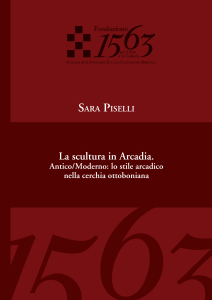Sculpture in Arcadia
by Sara Piselli
Written in response to Fondazione 1563 per l’Arte e la Cultura 2014 Research Call, asking for contributions addressing the theme of ‘Ancient/Modern’, Sculpture in Arcadia tackles issues of patronage and collecting choices in the field of sculptural production in Rome at the turn of the eighteenth century. In particular, Sculpture in Arcadia looks at the exemplary case study represented by Cardinal Pietro Ottoboni and the artists of his cultural circle. Previous studies on Cardinal Ottoboni have been important in recognizing the Cardinal – Venetian in origins – as a highly influencial figure on contemporary cultural and artistic debates in Rome. Nevertheless, except for Edward Olszewski’s book on Alexander VIII’s funerary monument in St Peter, the copious studies on this exceptional figure of patron only marginally touched upon his sculptural acquisitions.
This research investigates Cardinal Ottoboni’s choices in terms of commissions and collection of sculpture in light of the discussions on this subject opened by Francis Haskell in his pivotal Patron and Painters (1963), and then by Edward Olszewski in more recent publications. Cardinal Ottoboni’s choices are assessed against the contemporary taste for sculpture, which here is reconstructed by con-sidering other contemporary patrons’ collecting choices and commissions, the success granted in this period to artists working in this medium and the authority enjoyed by ancient and modern sculptural precedents, within the larger frame of Arcadian culture in Rome.
The methodology employed for this study consisted firstly in an examination of those works known to be part of the Cardinal’s collection, together with a broadening and a critical review of previous studies which had focused on the artistic and cultural context of Rome at the turn of the eighteenth century. Also, this research reconsidered a large part of the documents referring to the Cardinal which are preserved in Roman archives. The Cardinal’s choices, as they emerge from these documents, have been compared with those of other contemporary Roman collectors, evidencing differences and similarities by comparison with in the role fulfilled by sculpture within other contemporary collections, with contemporary taste, and in relationship with the sister arts of painting and architecture in this period.
In addition, this research examines Arcadian literary sources which refer to the visual arts, with a specific focus on poems found in manuscripts collected at the Biblioteca Angelica in Rome, and on the volumes printed for award ceremonies in the occasion of Concorsi Clementini. Analysing how the Arcadians referred to art objects in these poems allows to understand their ideas on larger artistic matters.
Cardinal Ottoboni’s career as patron of sculpture begins with commissions to the authoritative artist Domenico Guidi. Nevertheless his sculptural taste soon identifies particularly with the production of the Genoese sculptor Angelo De Rossi, pupil of Filippo Parodi. Angelo De Rossi improved his tech-nique in Rome through the study of ancient and modern works and through attendance to drawing academies. He had achieved such a facility with the latter that Nicola Pio said of him “he made excel-lent drawings, more in the style of a painter than in that of a sculptor, and he has been one of the major artists in Rome and in Italy”.
The Genoese artist stood out particularly among his fellows for his masterful mezzorilievo, which he finished with such a sensibility that his works became well known in the Roman and international context.
His ability in modeling, exemplified by works realized both for the Cardinal and for other patrons, shows great delicacy in the use of the chisel, combined with a refined sensibility in rendering natural-ness, mitigated by pathos. All these features of his sculptural production embodied perfectly the Arcadian taste, which was also exemplified by another artist from the Ottoboni’s circle, Francesco Trevisani. Cardinal Ottoboni’s choices as patron of sculpture can be recognized as particularly consistent in the period between the end of the seventeenth century and the end of Clemente XI’s pontificate. During these years the production of these two artists helped him to shape a entirely original character for his sculptural taste. This period ended with the early death of the Genoese artist.
By investigating Cardinal Ottoboni’s exemplary case study as patron of sculptural productions, this research opens up new perspectives for further studies on this period of art history. Although sculptures were numerically inferior than paintings in contemporary collections, this study shows that sculptures and artists working in this field had an important role in defining cultural and artistic choices in eighteenth century Rome.

Title: La scultura in Arcadia. Antico/Moderno: lo stile arcadico nella cerchia ottoboniana (Sculpture in Arcadia)
Author: Sara Piselli
Series: Alti Studi sull’Età e la Cultura del Barocco
Publisher: Fondazione 1563 per l’Arte e la Cultura della Compagnia di San Paolo
Year: 2017
Pages: 245 pp.
Language: Italian
Isbn: 9788899808099



